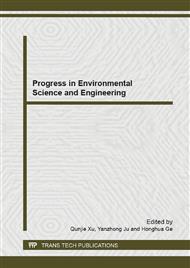p.1130
p.1134
p.1139
p.1146
p.1150
p.1155
p.1162
p.1166
p.1170
Temporal and Spatial Patterns of Temperature and Humidity in Taxodium distichum Shelterbelts of Jiangmen, South China
Abstract:
Temporal and spatial patterns of temperature and humidity in shelterbelts of Taxodium distichum were investigated using routine observation and gradient observation methods in sampling plots placed in Taxodium distichum shelterbelts, sugarcane, and open (blank) fields, respectively. The results showed that: 1) Taxodium distichum shelterbelts mitigated air temperature in July. Air temperature of Taxodium distichum shelterbelts was 0.7 °C and 1.7 °C lower than that of sugarcane field and blank field in July, respectively, while less change of air temperature in January was recorded. Air temperature at 20 cm from the ground in the Taxodium distichum shelterbelts was the highest in April, October and January, but the lowest in July; 2) Relative humidity in the Taxodium distichum shelterbelts was higher than in blank field through the four seasons, but lower than in sugarcane field in July, October and January. Relative humidity in sugarcane field and Taxodium distichum shelterbelts was higher near the ground, and relative humidity in sugarcane field increased significantly; 3) One-way ANOVA followed by Tukey’s HSD indicated that both air temperature and relative humidity were significantly different with a seasonal pattern among shelterbelts of Taxodium distichum, sugarcane field and open field (P<0.001).
Info:
Periodical:
Pages:
1150-1154
Citation:
Online since:
December 2012
Authors:
Price:
Сopyright:
© 2013 Trans Tech Publications Ltd. All Rights Reserved
Share:
Citation:


